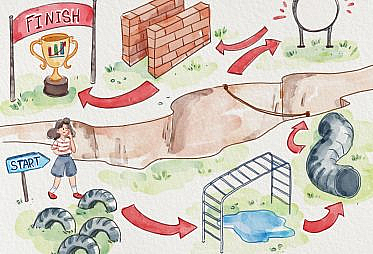Providing clarity and structure around expectations empowers your team members to decide what skills and competencies to focus on improving. However, writing the career ladder is only the beginning of using it well – to get the most value, you have to effectively communicate it to your team and use it as a jumping off point for specific, growth-oriented development conversations.
This is part 3 of a series on career ladders – you may want to read part 1, why a career ladder is so important, and part 2, how to create a career ladder before proceeding.
Roll Out the Ladder to Your Team
Hopefully, your team knows you’re creating a career ladder, and was involved in specifying the skills and competencies within it. But once you’ve finalized your ladder, share it again with your team. Explain why it exists and how you’ll use it. Set clear expectations on what levels mean, and how it will be used. Some of the specific questions I try to answer include:
- Does promotion require demonstrating 100% of the competencies laid out for each level, or is there room for folks to specialize and exceed expectations in one area while not meeting the threshold in another?
- Does your company promote people they believe have the ability to achieve at the next level, or must someone have already demonstrated that level of work for 3 or 6 months before they are eligible for promotion?
- Is there a fixed promotion schedule or is it ad-hoc?
- How do you get nominated for a promotion? Is it self-driven or manager-driven? Do you need to create a promo portfolio, or is it less structured than that?
- How does level affect salary?
- How does your team’s ladder fits into the overall company approach to leveling and salaries, if there is one?
- Can team members expect a promotion on some regular cadence, like annually? How long should they expect to be in each level to develop the skills and competencies for the next?
- Given the size of the team, how likely is the transition from individual contributor to manager track? Are there any roles on the ladder the company will have to demonstrate a compelling need for before they are really an option for promotion?
- Is it ok NOT to be constantly working toward a promotion? (The answer here should certainly be yes – there are times when professional growth isn’t someone’s priority, and continuing to do good work at their current level is perfectly reasonable and still adds a ton of value.) Answer any other questions that come up, and make sure your team understands that this is a living document which will likely change over time.
Have Regular Growth Conversations
Have regular, growth-focused conversations with your team members. The cadence and content may vary, but I’ll outline what has worked for me.
- When someone joins my team, I have a general career conversation with them to understand where they want to go and how their current position can help them get there. Occasionally I learn, “I don’t actually want to be a Senior Analyst, I want to become a Product Manager.” If so, I do what I can to help them work on developing skills and getting involved with projects that will help them make that transition, while still adding value to the data team.
- For folks who do want a promotion on my team, we check in on the career ladder roughly twice a year. The team member and I go through the ladder separately to benchmark where we believe they are in regards to each competency. Doing this assessment independently and then comparing helps highlight areas of misalignment, which may be due to lack of clarity in the job ladder, a lack of self-awareness from your team member, or you not understanding their work or experience. Resolving that misalignment makes the next conversation, about growth areas, more focused and productive. A rubric similar to this one, previewed below, can help ensure that everyone understands clearly how they are progressing. In particular, it forces you to very clearly communicate whether someone is doing a great job at their current level, or whether they are performing at the next level for each skill and are on the path to a promotion. This is a common point of miscommunication between managers and individual contributors, and can create a sticky situation during reviews.

- Armed with those benchmarks, we create a growth plan together by agreeing on a few areas where they haven’t yet been able to demonstrate the skills or proficiencies for the next level, and they want to focus on improvement. Then we identify concrete projects and actions that will give them an opportunity to build and showcase their skills over the next several months. If they have any ongoing responsibilities or projects that don’t align with these growth areas, determine what will happen to those projects – can they be handed to someone who will get more out of them? Can you give them a bigger role on those projects, so that there is still growth opportunity?
- Keep checking in on those priorities. Keep them in your 1:1 agenda or set monthly reminders to make sure your team member is able to make progress where they want to. Adjust workloads or expectations as necessary. Help your team member solicit feedback from others regularly as well – do the key stakeholders for their work have any interim feedback that will help them improve?
- About 6 months later, you’ll check back in and see how the plan has gone. Keep a running document, with descriptions or links to work demonstrating various competencies. Hopefully, the assessment looks a little bit different as they’ve worked on a growth area, and you can determine a new area of focus. And if the person is nearing the next level across competencies, you can talk about when that person should be nominated or nominate themselves for a promotion.
These structured conversations help to break down growth plans into achievable scope and align the needs of the organization (in the form of upcoming projects) with the personal desires of your team. They also create a running record of growth that can be used in formal performance reviews and promotion nominations.
Align Team Responsibilities to Their Growth Opportunities
It takes concerted effort to make space for individual growth priorities while ensuring all of the team’s commitments are met, especially in a high growth company where the team likely has aggressive goals. It is tempting to simply align people with the projects where they already have necessary skills so that the team can quickly and efficiently meet their goals. However, you, as a manager, are responsible for making sure folks aren’t siloed any more than they want to be (and sometimes not even if they want to be), and that they have opportunities to stretch into new areas. There are a few approaches I’ve found helpful for this:
- Create rotating roles like ad-hoc request triager or interruptee. A triager might be responsible for monitoring a Slack channel where requests come in, routing requests to logical owners as needed, and tackling requests without a logical owner. I have traditionally given this role to new team members for their first 6 months or so as a way to get to know lots of people within the company, get acquainted with a wide range of data sources, and get interrupted often when they are likely working on fewer big projects. Meanwhile, it gives the rest of the team space to focus on substantive projects without interruption. Often within 6-8 months I’ve had a new team member to hand the role off to, but if not, rotate among the team (rotating day by day works well) to make sure no one is stuck spending too much time on ad-hocs for too long. It’s helpful if the team manager also takes on this role – your team will appreciate it, and it gives you a good perspective on individuals who might need more training on ad-hoc tools, overly manual processes, and other areas where a bit of work could cut down the demand for ad-hoc work.
- On a quarterly basis, create OKRs for the team and assign each an owner. This gives you the ability to proactively think through how projects are going to be distributed and align projects with the skills your team is trying to build. Most of these projects will be based on company-wide priorities, but sometimes it also makes sense to sneak in a project specifically focused on a growth area for someone on your team. This kind of project should be valuable to the company, but may not have made the cut if not for its alignment with a development plan.
- Create training partnerships. Encourage team members with very different skill sets to swap roles on a project, but to rely heavily on each other for support and training. Pair someone who is strong at communicating the conclusions of analyses with someone who has mostly been working on data transformations, and have them co-own a project where they can each tutor the other on their area of expertise. This undoubtedly makes projects take longer than they would if everyone played to their current strengths, but helps build a more robust and well-rounded team.
Manage Upward and Understand the Promo Process
Before promotion time approaches, make sure you’re communicating with your manager about where your team members stand and when you’d like to nominate them (or when they’ll likely be nominating themselves, if that’s how your org works). Understand the promotion process, likelihood of promo approval, any limits on the number of promotions (e.g. no more than X% of employees should be promoted per year), and how you can help your team be ready. Use that information to set expectations appropriately for your team, and find avenues for growth even if it they aren’t likely to get a promotion this cycle.
Manage Team Member Expectations
There will be promotion cycles when someone on your team is strongly hoping for, maybe even expecting, a promotion that isn’t going to happen. This can either happen because the individual hasn’t quite demonstrated the competencies necessary for the next level, or because despite their performance, you cannot get their promotion approved. In either case, it’s important to handle that conversation up front, as early as possible.
If there is a gap between their understanding of their performance and yours, be very clear on where they haven’t yet demonstrated their skills and what opportunities they will have to do so over the next few months. Communicate with them often on their progress over the next several months, and be sure they understand whether they are on track for the next promotion cycle or not to prevent any surprises.
If they have demonstrated everything necessary for the promotion but you weren’t able to get it approved, be as honest as you can without passing the buck. Make sure they understand any company-wide limits that affected them (e.g. the team didn’t have any promo slots available this round), any specific internal headwinds that impacted the decision (e.g. they have been doing great work, but it hasn’t been visible enough for the executive team to support the promo), and what you’re going to do to get them the promo next round. Maybe they need to work on a highly visible project, or present their work to senior leadership more often. Maybe it’s just a matter of time, and you’re confident they will get the promotion next time – but you had better be very sure of that, aligned with your manager and other promotion approvers, before you share with your team member.
Announce Promotions Loudly and With Specific Positive Feedback
Announcing promotions are one of the most fun parts of managing a team. First, telling the person who is being promoted, then telling the entire company – it’s chock full of warm fuzzies. But promotion announcements are also a powerful opportunity to reinforce the principles that underpin your career ladder to both the person being promoted and everyone else. What work did they do that showed they had made that step function from one role to another? If there are undersung skills they demonstrated – unblocking and mentoring teammates, or focusing on automation to empower people to focus on higher-value work – now is the time to make sure everyone knows that these things really do help you reach the next level.
Hire Folks at the Right Level
Talk to candidates about the career ladder, and how you use it – the fact that the company takes a clear and structured approach to coaching and development is a significant selling point. Within the hiring process, use your ladder to align candidates with levels. Create interview questions designed to tease out where someone is in relation to your levels, and hire them in accordingly. Make it clear when you give them an offer what level they are being offered, and talk about level before they accept. The level you’re offering may not align with their current level, or where they think they belong, so make sure they understand why that level, and what it will take to get to the next level.
What If You Don’t Have a Career Ladder?
All of this is great if you manage a team and can lead the effort to clarify career paths. But let’s change perspective here – what if you are an individual contributor, and you don’t have a career ladder? You aren’t responsible for creating the ladder (yet), and your manager may not consider it a priority, but you want more clarity around your growth path and promotion potential. Here’s one approach to handling that situation:
- Understand the promotion process within your company. Ask your manager and/or HR to help you get clarity around when promotions happen, what kind of documentation you’ll need for it, who has to approve it, whether there are promotion benchmarks or limits, and any other details about the process.
- Ask your manager if there is a career ladder. Sometimes there is a document floating around somewhere, but it isn’t used effectively. You can help them leverage what already exists!
- If there is no ladder, borrow someone else’s. Find a ladder as close to your role as possible. Make a copy of it, and change anything that is glaringly not applicable or missing to align with your role. Don’t spend too much time on this, just get it in the ballpark so you can start a real conversation.
- Schedule time with your manager to review the ladder, whether it’s an unused internal document or an external document. Tell them that you would like more structure around your growth priorities, and ask them if the ladder is a reasonable representation of skills you need to reach the next level. Adjust as needed, but at this point it doesn’t have to be perfect or comprehensive – just good enough to give direction for the next few months.
- Use the review process outlined above: you and your manager should both assess where you are on the ladder, and align on any discrepancies. Then choose a few areas to focus on over the next 3-6 months, and work with your manager to find specific projects that will let you flex those skills.
- Go do great work.
- After one or two rounds of this, ask your manager very specifically what still stands between you and your next promotion. This is when a borrowed ladder may not be good enough – they may not write a full ladder for you, but after some clear, structured conversations about your progress, your manager should be able to communicate clearly what you still need to do to be considered for promotion.
- Go do more great work. Keep asking specific questions and checking in on the focus projects you identified. Follow up with your manager on the promotion process and expectations.
Conclusion
The process of creating a ladder and using it well sparks important conversations about priorities and growth. As analytics teams continue to evolve, a solid framework for growth can be relatively easily adapted to emerging role and specialties, while still providing structure around career advancement, mitigating bias, and helping eliminate glue work. I would love to hear more about your own experience – do you ever actually use your career ladder? How has it impacted your growth trajectory? Send me an email or come have a chat in our Slack channel!






